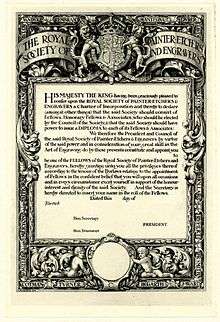Royal Society of Painter-Printmakers

The Royal Society of Painter-Printmakers (RE), known until 1991 as the Royal Society of Painter-Etchers and Engravers, is an art institution based in London, England. The Royal Society of Painter-Etchers and Engravers was a society of etchers established in London in 1880 and given a Royal Charter in 1888.
History
The Society was established as the Society of Painter-Etchers for the promotion of original etching as an art form, inspired by the French group of the same name which existed in Paris. The first six fellows, all elected on 31 July 1880, were Francis Seymour Haden, Heywood Hardy, Hubert von Herkomer, Alphonse Legros, Robert Walker Macbeth and James Tissot (Whistler had a row with his brother-in-law, Haden, and would not join). It achieved its Royal Charter in 1888, becoming the Royal Society of Painter-Etchers and Engravers. Fellow, George W. Eve, designed a new diploma in 1904.[1]
By 1911, when King George V granted a Charter of Incorporation and Bye-laws, the RE, as it came to be styled, had grown in prestige and become fully established. From 1919, in token of solidarity, Presidents of the Royal Academy have always been elected Honorary Fellows of the RE.
The Society of Painter-Etchers had remarkably few Presidents. They were: Sir Francis Seymour Haden (1880–1910), Sir Francis Job Short (1910–1938), Malcolm Osborne (1938–1962), Robert Austin (1962–1970), Paul Drury (1970–1975), Harry Eccleston (1975–1989), and Joseph Winkelman (1989–1991), when the Society was renamed. Winkelman continued as President until 1995. Presidents after this were David Carpanini (1995–2003), Anita Klein (2003–2006), Hilary Paynter (2006–11), Dr Bren Unwin (2011–13) and Mychael Barratt (2013–).
Membership
In 1920 the membership was expanded to allow artists who produced prints from media other than metal, which allowed the election of woodcut artists such as Gwen Raverat. Another innovation in the same year was the formation of a Print Collectors' Club to be limited to 300 members each of whom received an annual presentation print.
Full fellows are entitled to use the post-nominals RE. Associates, a class of members established in 1887, can use ARE.
Notable members (and their date of election to a full fellowship) included: William Strang (1881), Joseph Pennell (1882), Auguste Rodin (1882), Charles William Sherborn (1884), Herbert Dicksee (1885), Walter Sickert (1887), Sir David Young Cameron (1895), Sir Frank Brangwyn (1903), Anna Airy (1908), Eugène Béjot (1908), Ernest Stephen Lumsden (1915), William Walcot (1920), Edmund Blampied (1921), Gerald Brockhurst (1921), Robert Austin (1927), Dame Laura Knight (1932), Sir William Russell Flint (1933), Charles Tunnicliffe (1934), Geoffrey Wedgwood (1934), Joan Hassall (1948) and Gwenda Morgan (1962). Others were elected as an Associate but did not achieve the full fellowship, such as Eli Marsden Wilson (1907), John Nicolson (1923) and Salomon van Abbé (1923).
The Society's is: Bankside Gallery, 48 Hopton Street, London, SE1 9JH, England.
References and sources
- References
- ↑ Viner, George H. (1916) A descriptive catalogue of the bookplates designed and etched by George W. Eve, R.E. Kansas City: The American Bookplate Society, p. 7.
- Sources
- Newbolt, Francis (1930). The History of the Royal Society of Painter-Etchers & Engravers, 1880–1930. London: Publication No. 9, The Print Collector's Club.
- Hopkinson, Martin (1999). No day without a line. The History of the Royal Society of Painter-Printmakers, 1880–1999. Oxford: Ashmolean Museum.
External links
- Royal Society of Painter-Printmakers website
- A brief history of the Royal Society of Painter-Printmakers by Joseph Winkelman PPRE